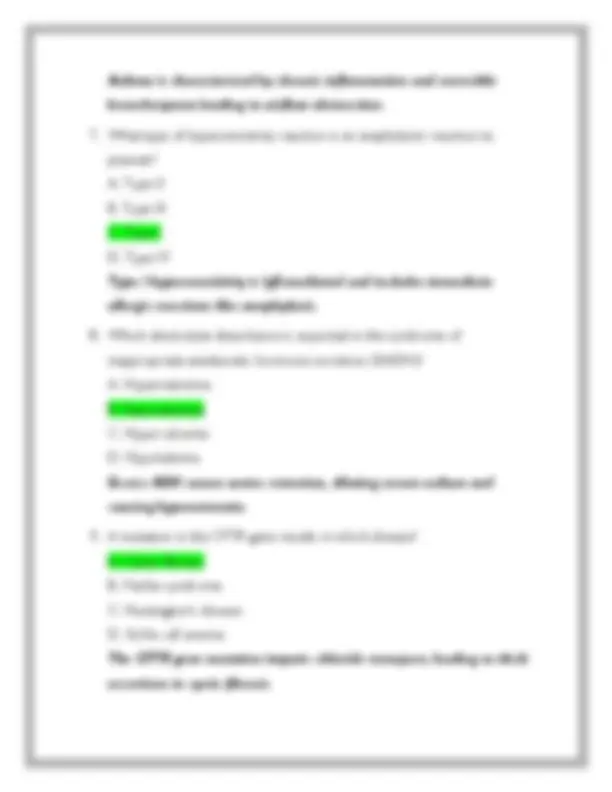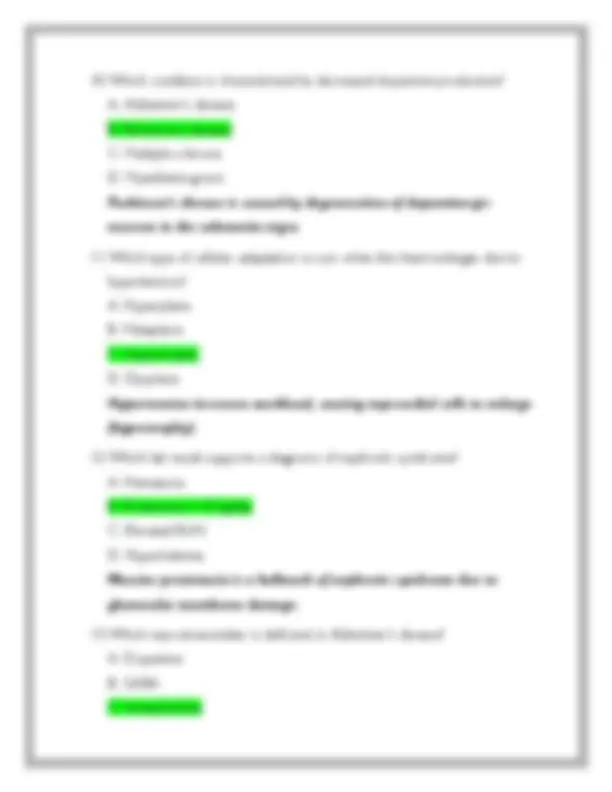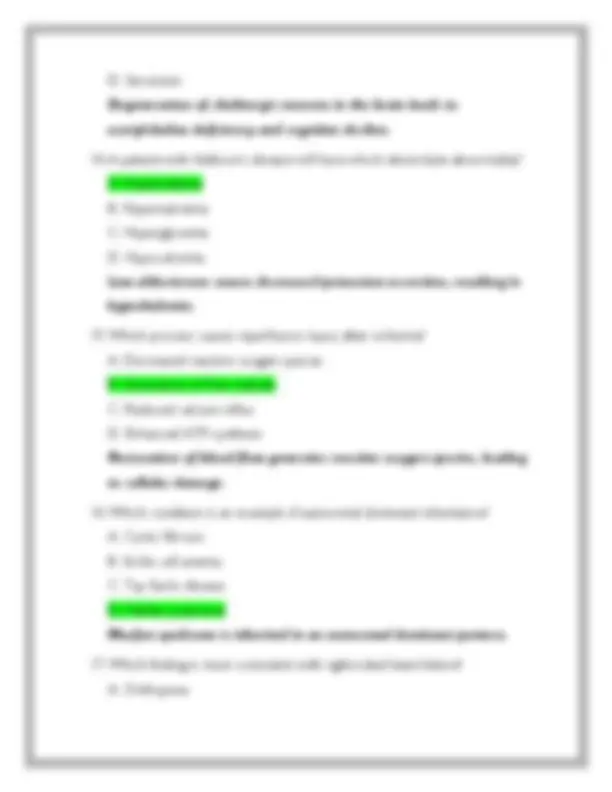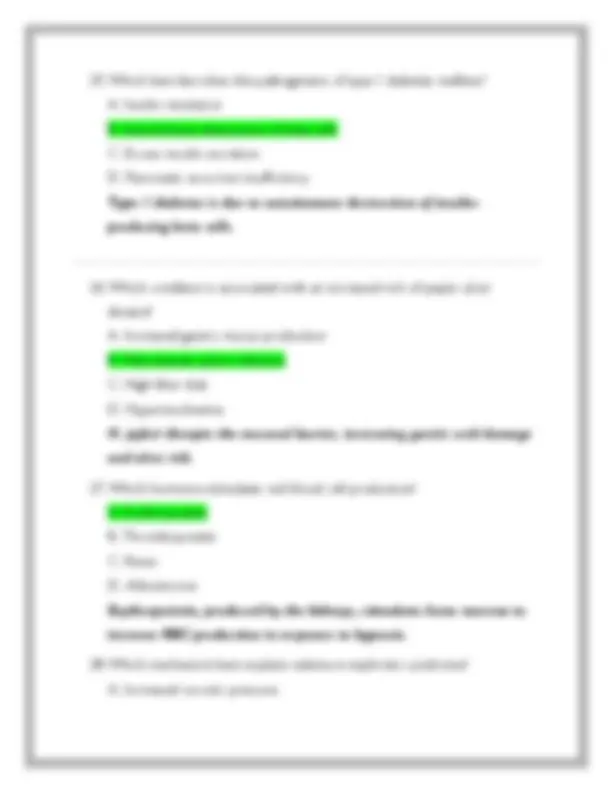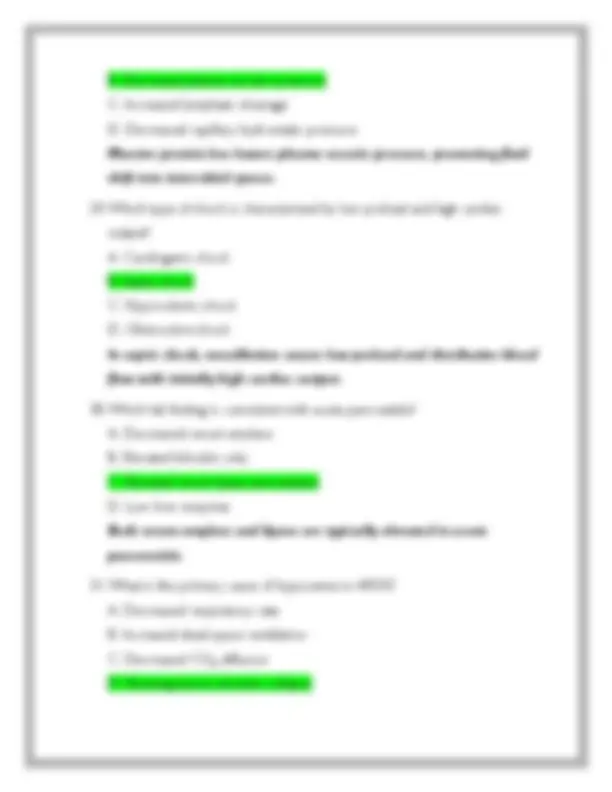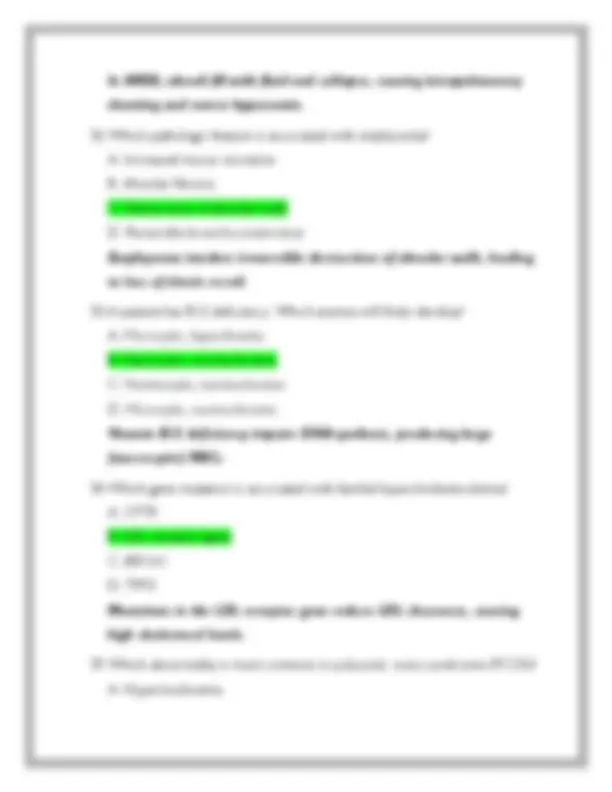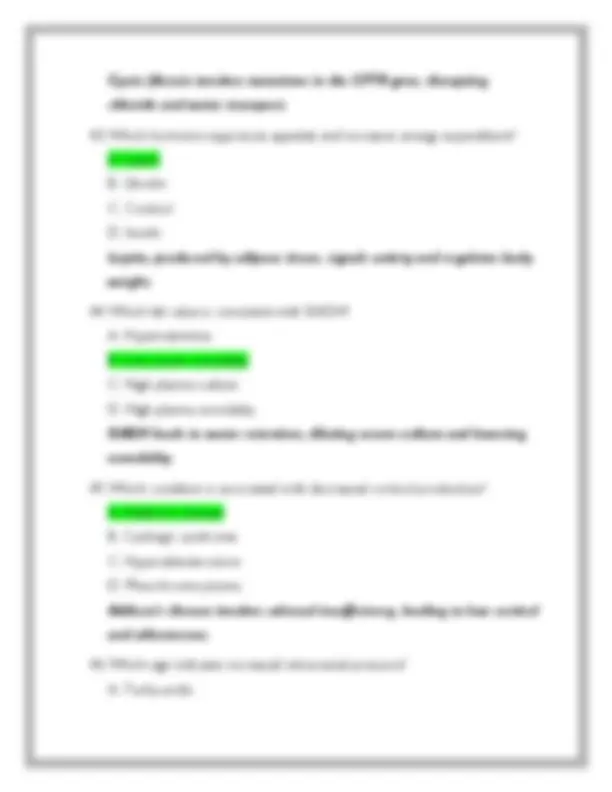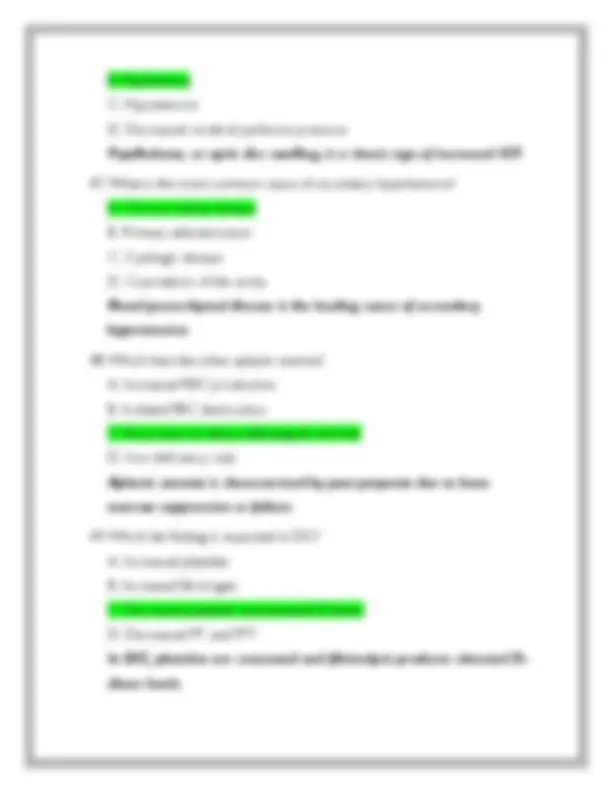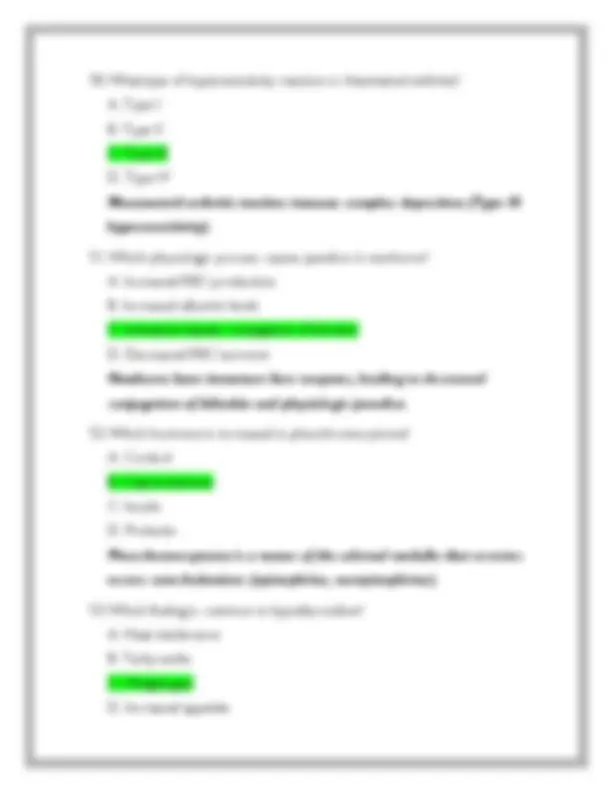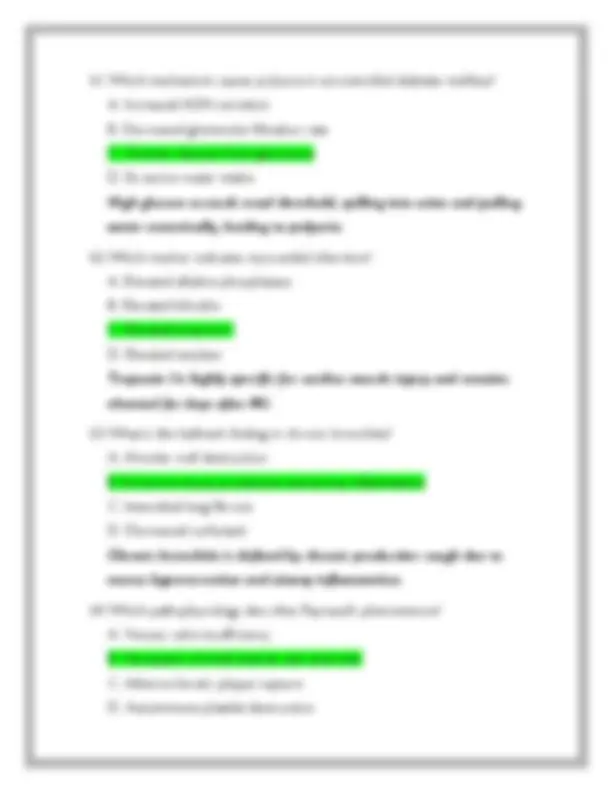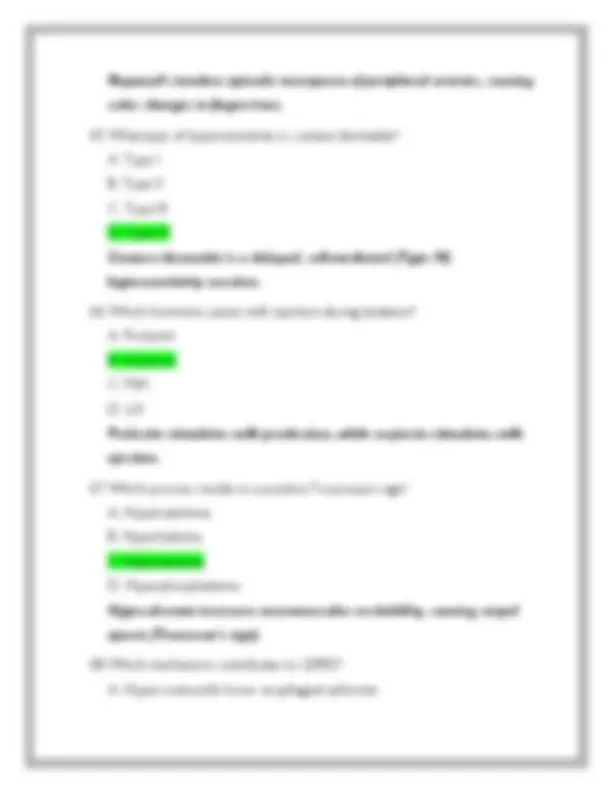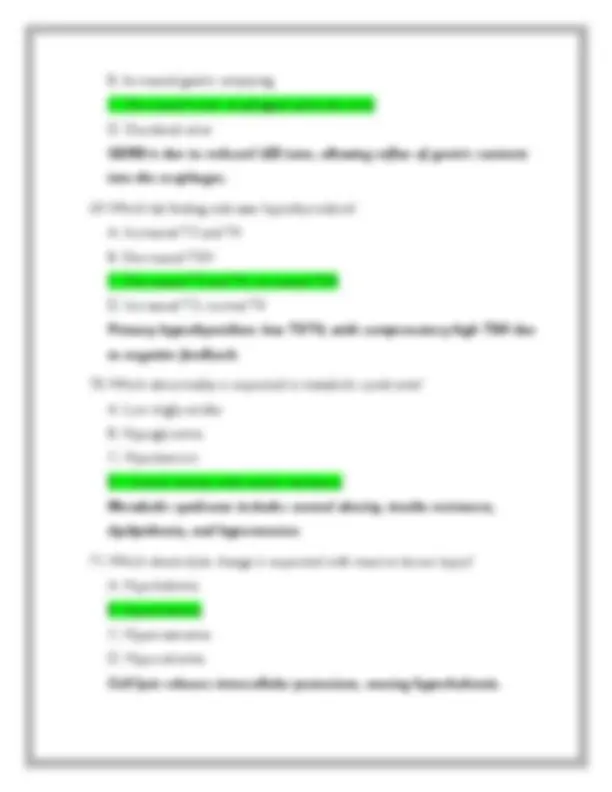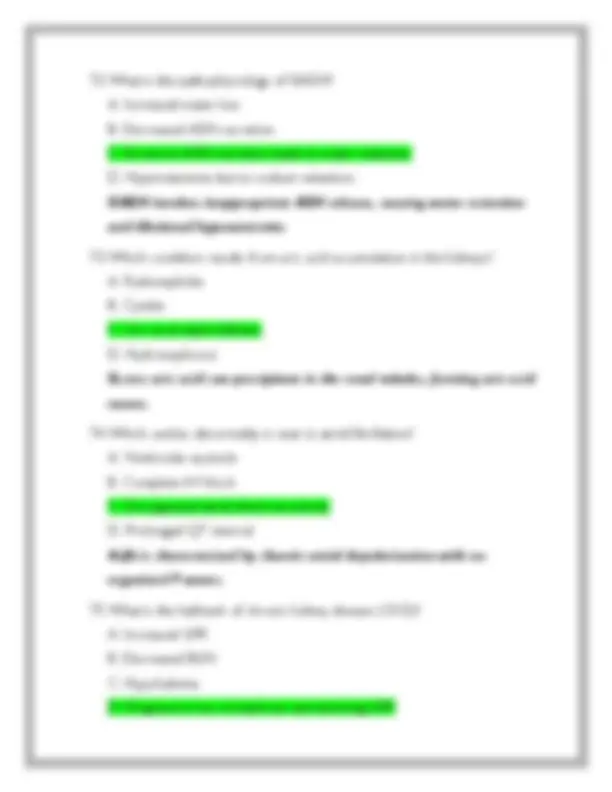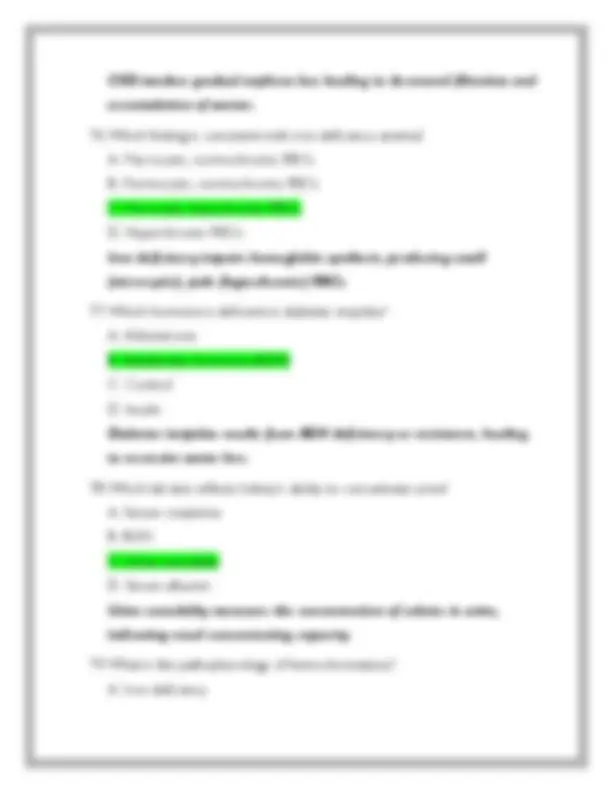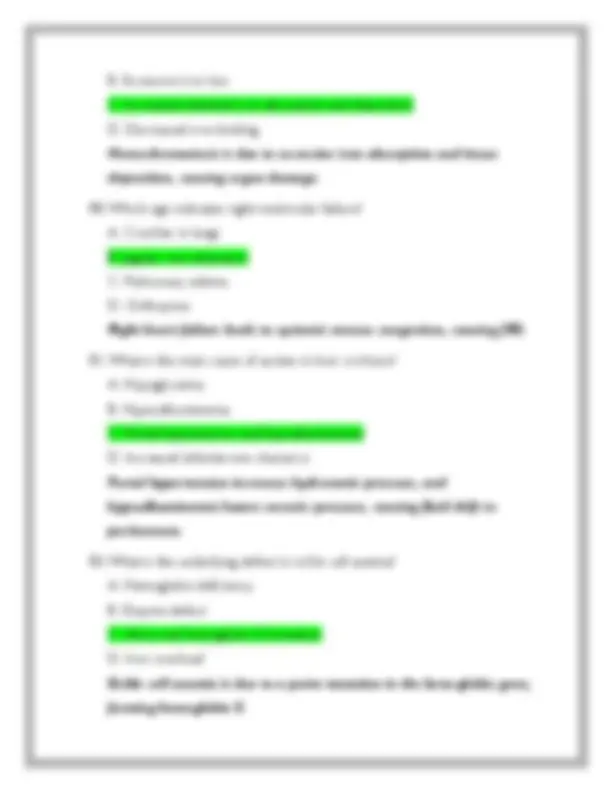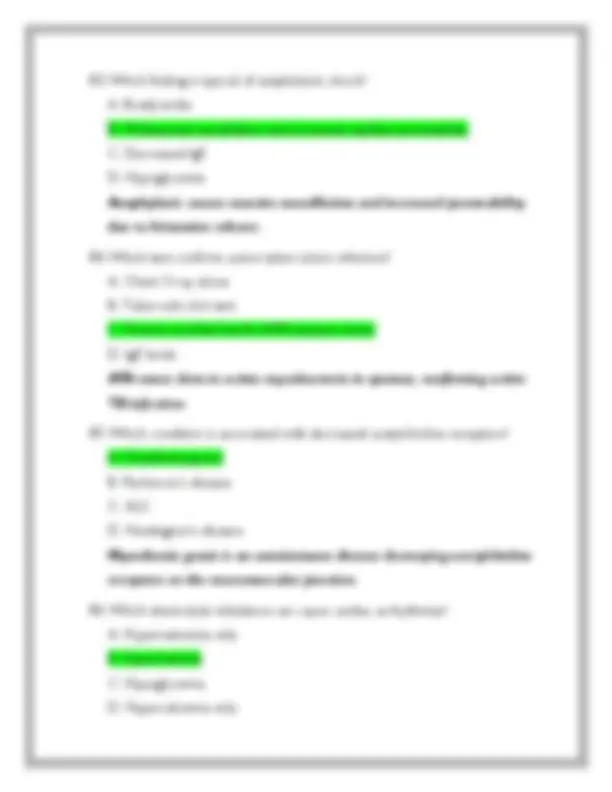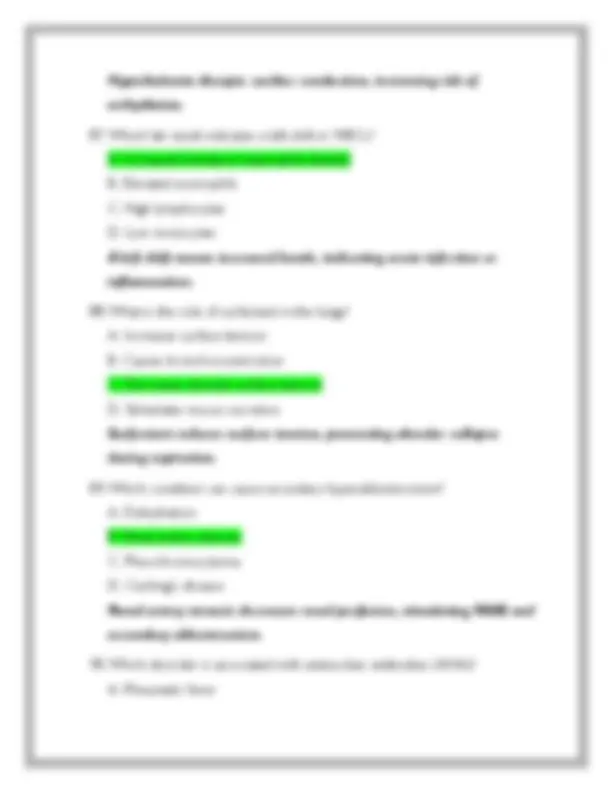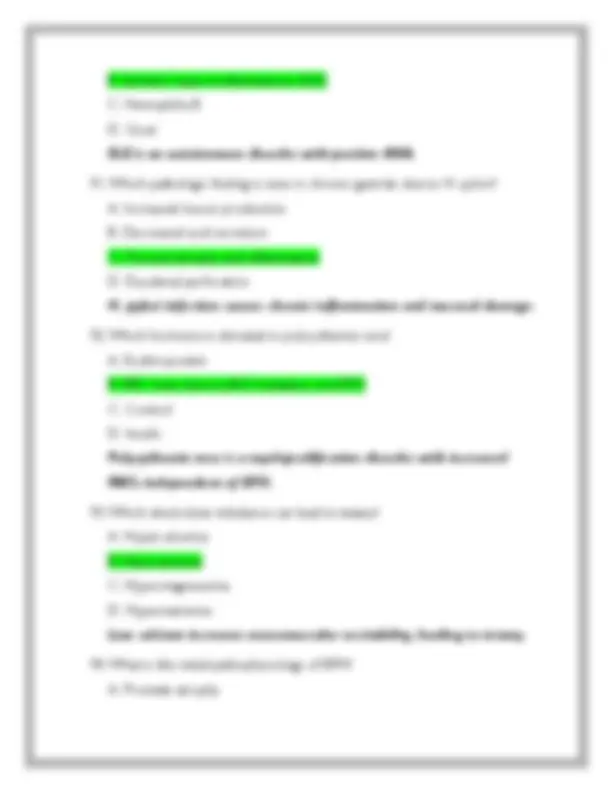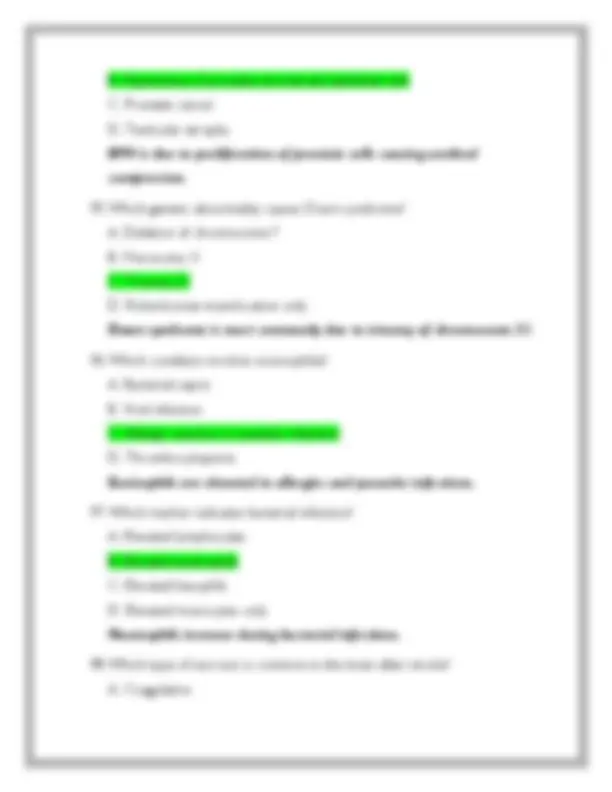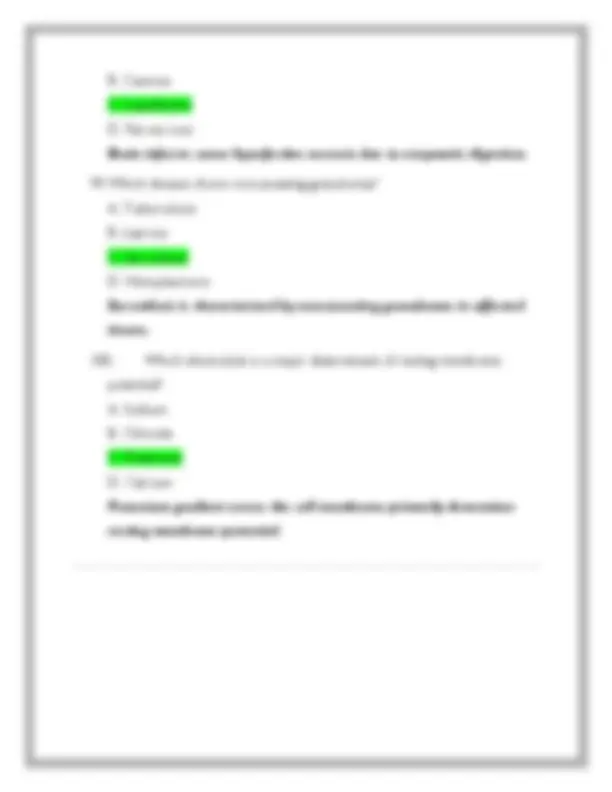Download NSG 6005 – Advanced Pathophysiology Exam Questions And Correct Answers (Verified Answers) and more Exams Pathophysiology in PDF only on Docsity!
NSG 6005 – Advanced Pathophysiology Exam
Questions And Correct Answers (Verified Answers)
Plus Rationales 2025 Q&A | Instant Download PDF
South University
- A patient with chronic obstructive pulmonary disease (COPD) presents with increased shortness of breath. Which pathophysiologic process is most likely responsible? A. Decreased surfactant production B. Increased alveolar ventilation C. Decreased airway resistance D. Air trapping and hyperinflation Air trapping occurs due to obstruction of airflow, leading to hyperinflation and worsening dyspnea in COPD.
- Which cytokine is primarily responsible for inducing fever during an inflammatory response? A. Interleukin-2 (IL-2) B. Interleukin-1 (IL-1) C. Tumor necrosis factor-beta (TNF-β) D. Interferon-alpha IL-1 is an endogenous pyrogen that directly acts on the hypothalamus to increase the set point, causing fever.
- In left-sided heart failure, which symptom is most directly related to pulmonary congestion?
A. Hepatomegaly B. Peripheral edema C. Dyspnea on exertion D. Jugular vein distention Left-sided failure causes backup into the pulmonary circulation, leading to fluid accumulation and dyspnea.
- Which mechanism contributes to insulin resistance in type 2 diabetes? A. Increased insulin receptor sensitivity B. Defects in insulin receptor signaling pathways C. Beta-cell hyperplasia D. Enhanced GLUT-4 transporter function Defects in receptor signaling reduce glucose uptake, contributing to hyperglycemia in type 2 diabetes.
- A patient with Cushing’s syndrome will likely have which laboratory abnormality? A. Hyperglycemia B. Hypotension C. Hyponatremia D. Hypokalemia Excess cortisol increases gluconeogenesis and decreases glucose utilization, resulting in hyperglycemia.
- What is the underlying pathophysiology of asthma? A. Alveolar wall destruction B. Loss of elastic recoil C. Reversible airway inflammation and bronchoconstriction D. Pulmonary fibrosis
- Which condition is characterized by decreased dopamine production? A. Alzheimer’s disease B. Parkinson’s disease C. Multiple sclerosis D. Myasthenia gravis Parkinson’s disease is caused by degeneration of dopaminergic neurons in the substantia nigra.
- Which type of cellular adaptation occurs when the heart enlarges due to hypertension? A. Hyperplasia B. Metaplasia C. Hypertrophy D. Dysplasia Hypertension increases workload, causing myocardial cells to enlarge (hypertrophy).
- Which lab result supports a diagnosis of nephrotic syndrome? A. Hematuria B. Proteinuria > 3.5 g/day C. Elevated BUN D. Hyperkalemia Massive proteinuria is a hallmark of nephrotic syndrome due to glomerular membrane damage.
- Which neurotransmitter is deficient in Alzheimer’s disease? A. Dopamine B. GABA C. Acetylcholine
D. Serotonin Degeneration of cholinergic neurons in the brain leads to acetylcholine deficiency and cognitive decline.
- A patient with Addison’s disease will have which electrolyte abnormality? A. Hyperkalemia B. Hypernatremia C. Hyperglycemia D. Hypocalcemia Low aldosterone causes decreased potassium excretion, resulting in hyperkalemia.
- Which process causes reperfusion injury after ischemia? A. Decreased reactive oxygen species B. Generation of free radicals C. Reduced calcium influx D. Enhanced ATP synthesis Restoration of blood flow generates reactive oxygen species, leading to cellular damage.
- Which condition is an example of autosomal dominant inheritance? A. Cystic fibrosis B. Sickle cell anemia C. Tay-Sachs disease D. Marfan syndrome Marfan syndrome is inherited in an autosomal dominant pattern.
- Which finding is most consistent with right-sided heart failure? A. Orthopnea
- Which condition is associated with hypercoagulability? A. Hemophilia A B. Von Willebrand disease C. Factor V Leiden mutation D. Thrombocytopenia Factor V Leiden mutation increases the risk of thrombus formation.
- Which electrolyte imbalance is expected in chronic renal failure? A. Hypophosphatemia B. Hypokalemia C. Hyperphosphatemia D. Hypernatremia Renal failure impairs phosphate excretion, resulting in hyperphosphatemia.
- Which finding suggests metabolic acidosis? A. Increased HCO₃⁻ B. Decreased pH and HCO₃⁻ C. Increased pCO₂ D. Increased pH Metabolic acidosis is defined by low pH and decreased bicarbonate.
- Which lab abnormality is consistent with liver cirrhosis? A. Elevated albumin B. Elevated bilirubin C. Increased clotting factors D. Decreased ammonia levels Hepatocellular dysfunction impairs bilirubin conjugation, increasing serum bilirubin.
- Which best describes the pathogenesis of type 1 diabetes mellitus? A. Insulin resistance B. Autoimmune destruction of beta cells C. Excess insulin secretion D. Pancreatic exocrine insufficiency Type 1 diabetes is due to autoimmune destruction of insulin- producing beta cells.
- Which condition is associated with an increased risk of peptic ulcer disease? A. Increased gastric mucus production B. Helicobacter pylori infection C. High-fiber diet D. Hyperinsulinemia H. pylori disrupts the mucosal barrier, increasing gastric acid damage and ulcer risk.
- Which hormone stimulates red blood cell production? A. Erythropoietin B. Thrombopoietin C. Renin D. Aldosterone Erythropoietin, produced by the kidneys, stimulates bone marrow to increase RBC production in response to hypoxia.
- Which mechanism best explains edema in nephrotic syndrome? A. Increased oncotic pressure
In ARDS, alveoli fill with fluid and collapse, causing intrapulmonary shunting and severe hypoxemia.
- Which pathologic feature is associated with emphysema? A. Increased mucus secretion B. Alveolar fibrosis C. Destruction of alveolar walls D. Reversible bronchoconstriction Emphysema involves irreversible destruction of alveolar walls, leading to loss of elastic recoil.
- A patient has B12 deficiency. Which anemia will likely develop? A. Microcytic, hypochromic B. Macrocytic, normochromic C. Normocytic, normochromic D. Microcytic, normochromic Vitamin B12 deficiency impairs DNA synthesis, producing large (macrocytic) RBCs.
- Which gene mutation is associated with familial hypercholesterolemia? A. CFTR B. LDL receptor gene C. BRCA D. TP Mutations in the LDL receptor gene reduce LDL clearance, causing high cholesterol levels.
- Which abnormality is most common in polycystic ovary syndrome (PCOS)? A. Hyperinsulinemia
B. Hypoandrogenism C. Hyperandrogenism D. Hypoglycemia PCOS is marked by excess androgen production, leading to hirsutism, acne, and menstrual irregularity.
- Which acid-base imbalance occurs with prolonged vomiting? A. Metabolic acidosis B. Respiratory acidosis C. Metabolic alkalosis D. Respiratory alkalosis Loss of gastric acid with vomiting leads to metabolic alkalosis due to hydrogen ion loss.
- Which lab abnormality is expected in hyperparathyroidism? A. Hypocalcemia B. Low PTH levels C. Hypercalcemia D. Hypernatremia Excess PTH increases bone resorption, raising serum calcium levels.
- Which hormone is responsible for increased sodium reabsorption in the distal tubule? A. Cortisol B. Aldosterone C. ADH D. Erythropoietin Aldosterone acts on the distal tubules and collecting ducts to promote sodium reabsorption and potassium excretion.
Cystic fibrosis involves mutations in the CFTR gene, disrupting chloride and water transport.
- Which hormone suppresses appetite and increases energy expenditure? A. Leptin B. Ghrelin C. Cortisol D. Insulin Leptin, produced by adipose tissue, signals satiety and regulates body weight.
- Which lab value is consistent with SIADH? A. Hypernatremia B. Low serum osmolality C. High plasma sodium D. High plasma osmolality SIADH leads to water retention, diluting serum sodium and lowering osmolality.
- Which condition is associated with decreased cortisol production? A. Addison’s disease B. Cushing’s syndrome C. Hyperaldosteronism D. Pheochromocytoma Addison’s disease involves adrenal insufficiency, leading to low cortisol and aldosterone.
- Which sign indicates increased intracranial pressure? A. Tachycardia
B. Papilledema C. Hypotension D. Decreased cerebral perfusion pressure Papilledema, or optic disc swelling, is a classic sign of increased ICP.
- What is the most common cause of secondary hypertension? A. Chronic kidney disease B. Primary aldosteronism C. Cushing’s disease D. Coarctation of the aorta Renal parenchymal disease is the leading cause of secondary hypertension.
- Which best describes aplastic anemia? A. Increased RBC production B. Isolated RBC destruction C. Bone marrow failure affecting all cell lines D. Iron deficiency only Aplastic anemia is characterized by pancytopenia due to bone marrow suppression or failure.
- Which lab finding is expected in DIC? A. Increased platelets B. Increased fibrinogen C. Decreased platelets and elevated D-dimer D. Decreased PT and PTT In DIC, platelets are consumed and fibrinolysis produces elevated D- dimer levels.
Hypothyroidism slows metabolism, leading to weight gain despite normal or reduced appetite.
- Which electrolyte disturbance is caused by loop diuretics? A. Hypokalemia B. Hyperkalemia C. Hypercalcemia D. Hypernatremia Loop diuretics increase urinary potassium loss, leading to hypokalemia.
- Which pathologic feature is characteristic of multiple sclerosis? A. Loss of acetylcholine receptors B. Beta-amyloid plaques C. Demyelination of CNS neurons D. Dopaminergic neuron loss Multiple sclerosis involves autoimmune demyelination of central nervous system neurons.
- Which factor increases the risk of deep vein thrombosis? A. Increased mobility B. Venous stasis C. Hypocoagulable state D. Hypovolemia Venous stasis slows blood flow, promoting clot formation and DVT.
- Which marker is used to monitor chronic glycemic control in diabetes? A. Fasting glucose B. Oral glucose tolerance test
C. Hemoglobin A1c D. C-peptide HbA1c reflects average glucose over 2–3 months and is used to monitor long-term control.
- What is the hallmark of acute glomerulonephritis? A. Proteinuria only B. No RBCs in urine C. Hematuria with RBC casts D. Hyperkalemia RBC casts are classic for glomerular inflammation and damage.
- Which pathophysiology best describes gout? A. Calcium deposition in joints B. Autoantibody-mediated joint destruction C. Monosodium urate crystal deposition in joints D. Hyaline cartilage degeneration Gout is caused by hyperuricemia leading to urate crystal deposition in joints.
- Which condition results from growth hormone excess in adults? A. Gigantism B. Acromegaly C. Dwarfism D. Addison’s disease In adults, GH excess after epiphyseal plate closure causes acromegaly (soft tissue and bone overgrowth).
Raynaud’s involves episodic vasospasm of peripheral arteries, causing color changes in fingers/toes.
- What type of hypersensitivity is contact dermatitis? A. Type I B. Type II C. Type III D. Type IV Contact dermatitis is a delayed, cell-mediated (Type IV) hypersensitivity reaction.
- Which hormone causes milk ejection during lactation? A. Prolactin B. Oxytocin C. FSH D. LH Prolactin stimulates milk production, while oxytocin stimulates milk ejection.
- Which process results in a positive Trousseau’s sign? A. Hypernatremia B. Hyperkalemia C. Hypocalcemia D. Hyperphosphatemia Hypocalcemia increases neuromuscular excitability, causing carpal spasm (Trousseau’s sign).
- Which mechanism contributes to GERD? A. Hypercontractile lower esophageal sphincter
B. Increased gastric emptying C. Decreased lower esophageal sphincter tone D. Duodenal ulcer GERD is due to reduced LES tone, allowing reflux of gastric contents into the esophagus.
- Which lab finding indicates hypothyroidism? A. Increased T3 and T B. Decreased TSH C. Decreased T3 and T4, increased TSH D. Increased T3, normal T Primary hypothyroidism: low T3/T4, with compensatory high TSH due to negative feedback.
- Which abnormality is expected in metabolic syndrome? A. Low triglycerides B. Hypoglycemia C. Hypotension D. Central obesity with insulin resistance Metabolic syndrome includes central obesity, insulin resistance, dyslipidemia, and hypertension.
- Which electrolyte change is expected with massive tissue injury? A. Hypokalemia B. Hyperkalemia C. Hypernatremia D. Hypocalcemia Cell lysis releases intracellular potassium, causing hyperkalemia.

